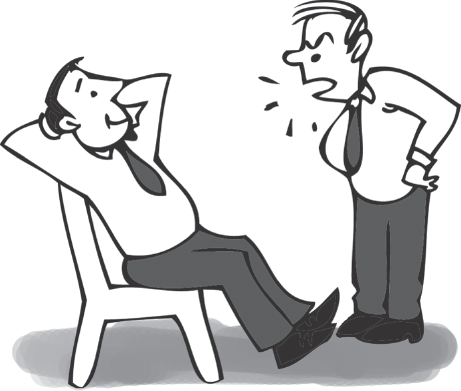17
Listening Skills
“To listen well is as powerful a means of communication and influence as to talk well.”
–John Marshall
God gave us two ears and one mouth. The ears are exclusively devoted for hearing whereas the mouth is supposed to do both speaking and eating. Perhaps, God intended that we should do four times as much listening as talking. More often than not, it is the reverse! Most people tend to do more talking than listening.
In our school days, we are taught reading, speaking, maths and a host of other subjects. But do we ever have a formal course on listening? Even our teachers, in their pressure to ‘teach’ the subjects, very seldom find time to listen to the feedback from the students, whether they (the students) have understood the message or not. The myriad self-improvement programmes that exist in the market make no more than a passing mention of listening skills, let alone offer concrete suggestions for improvement. The purpose of this chapter is to look a little deeper into listening and provide practical tips to improve listening, in our quest to improve communication.
Perhaps, the best way the importance of listening is highlighted is by one of the seven habits propounded by Stephen Covey (referred to in Chapter 9): ‘Seek to understand before seeking to be understood.’ Listening is the process by which you seek to understand someone else’s communication and point of view and thereby, relate to the environment better.
Right from our school days, we have to spend almost seven hours a day listening in the classroom (although most of time we only ‘hear’!). This continues into our work environment, where very seldom do we get closeted into one man armies. We need to work in teams and this involves a lot of listening to and empathizing with others’ point of view.
Listening starts with the physical process of hearing. But it is more than just hearing. Listening is to hearing what observing is to seeing. All of us see or hear; but not all of us observe or listen. Listening is the process of comprehending what the speaker said and understanding the speaker’s point of view. More importantly, listening also involves making the speaker understand that the listener has understood what the speaker has said and meant. This is what is generically referred to as active listening—the process by which a listener listens, understands the message the way it was intended and conveys to the sender that the message is understood as intended. Any other types of listening (if it can be called listening) are what we will term as passive listening. From now on, we will only discuss active listening and the steps towards sharpening it.
17.1 Steps in Active Listening
In order to achieve effective active listening, there are a number of steps that have to take place:
Understand the purpose for which you are listening.
Understanding why you are listening and what you are listening to: This is the essential first step in listening. Are you listening for exhaustive comprehension like in a training programme or in a class? If so, you would have to sustain your ‘listening energy’ over an extended period of time. Are you listening selectively, i.e., you are specifically interested in just a part of what is being said? If so, you need to up the ante during certain periods, while you could afford to slacken in listening at other times. For example, in a long product presentation by a vendor, your role may be to understand the technology part of it and hence you may have to selectively listen to this part with more attention. Are you listening to critically evaluate what is being said? For example, when you are evaluating a vendor’s presentation or performing a project review, you should be prepared to think on your feet and pose challenging questions. Are you listening empathically? For example, one of your staff needs a one-on-one with you to discuss some of his grievances. In this case, you should constantly try to put yourself in his shoes when you listen. You should also given him confidence that you have understood his point of view (though you may not agree with it). The various purposes for which you listen are given in Table 17.1.
Table 17.1 Various types of listening needed
| Type of Listening | Scenarios Where this will be Needed | Tips and Challenges |
|---|---|---|
| Exhaustive comprehension | Training programmes; classroom settings |
• Sustaining listening energy and concentration over extended period of time • Taking notes can help in this. |
| Selective listening | When you are assigned a specific responsibility to understand a specific part of what is being said |
• ‘On demand’ upping the ante for listening • Being aware of when to tune in and when to tune out |
| Evaluative listening | When you have to give your feedback and evaluation on part or all of a presentation |
• Would need upfront preparation to understand the evaluation factors • Would need to ask the right questions • Should be able to go into detail, and at the same time, understand the big picture |
| Empathetic listening | Typically applies when you are in an appraisal meeting or listening to customer complaints. |
• Need to put yourself in the shoes of the speaker and appreciate his perspective • Empathy need not mean that you fully agree with what the speaker is saying; all you are doing is to acknowledge that you have understood the speaker’s perspective; this is a delicate balance. |
Knowing the purpose of listening enables you to put sufficient energy and focus at the right times during a communication transaction.
Tune out unnecessary signals. Tune out unnecessary signals.
Just like an antenna tuned in to receive a specific broadcast filters out all other signals, the listener has to tune out all unnecessary signals. This is both a physical and mental process. On the physical side, the listener should
- Turn off unnecessary distractions. For example, turn off mobile phones, laptops and any such communication equipment.
- Minimize exposure to diversions. For example, instead of sitting overlooking a glass window, try to sit facing the wall.
- Consciously cut off other distractions like looking out of the window or scribbling on a note book or bringing up irrelevant topics for discussion.
- Refrain from side conversations with others in the room.
On the mental side, tuning out unnecessary signals involves:
- Putting away any distracting thoughts (‘how will the traffic be when I am returning home?’)
- Stop thinking about those urgent pressures like deadlines.
- Put your biases and judgemental feelings about the speaker or the topic aside so that you can listen objectively.
Tune in to the speaker.
You should not only tune out unnecessary signals, but also tune in to the speaker. This is again like how an antenna works by amplifying the required frequency. Tuning in to the speaker involves:
Using a posture that favours understanding and conveys confidence to the speaker: This point and the next one apply to body language (which is covered in more detail in Chapter 18). Sitting back in your chair as if you are watching a boring cricket match is neither going to increase your listening ability nor is it going to inspire any confidence in the speaker whom you are listening to (see Figure 17.1). Ditto to if you are lying down with your head on the table (Figure 17.2). At the same time, if you sit very straight it may be construed as intimidating. The best posture for effective listening is to sit bending a little forward (Fig. 17.3). This shows a sense of anticipation, almost like the person in a relay race ready to take the baton. If there is a table in front of you, leaning forward with your elbow every now and then will be a good posture for listening. Make sure you don’t get physically tired of whatever posture you choose. Else, your focus will only be on your physical discomfort and not on the subject matter you are listening to.
Providing eye contact to the speaker: Just as a speaker should provide selective eye contact to the listeners, the listener should provide periodic and selective eye contact to the speaker. The same benefits of eye contact that apply to a speaker also apply to a listener.
Perform the physical process of hearing.
Again, it is important to remember that this is more than a physical process. Some of the steps given below transcend sheer physical functioning and bring in a mental and psychological angle.
Look for the main ideas: Any communication you hear would have the main ideas that are substantiated by details and supporting facts. It is important that as a listener you catch the main ideas and sieve them from the details. This is especially true if you are performing critical listening or evaluative listening. Some speakers highlight such main points by phrases like ‘the point to note is…’ or ‘what I would like to stress is…’. Some use effective voice modulation (including pauses and suspenseful silence). But, some others just don’t give such cues. Regardless of whether the speaker gives these cues or not, the listener should develop the habit of looking for main ideas and separating out the essence from the details (see Box 17.1).
‘The important point is…’
‘What I would like to stress is…’
‘Note here, ladies and gentlemen… ‘(and a poignant pause before the next word)
Special effects on the visual aids….
Put your emotions aside while you listen: Emotions are valves that shut off hearing and listening when they feel like it! Emotions and strong biases will make you hear what you want to hear and not what the speaker wanted you to hear. You will end up with a jaundiced view of the inputs that is not going to help you get an objective understanding of the message.
Defer all judgment and conclusions till you finish listening: As an extension to the previous paragraph, remember, do not try to be judgemental when you listen. Do not let the communication go tangential because of counter-arguments stemming from your predetermined mindset. You will end up in an unnecessary adversarial position with the speaker that is not going to take the communication too far.
Reflect on what you heard.
Reflecting on what you heard is what distinguishes active listening from passive listening. Reflection means conveying to the speaker your understanding of what you heard. This can enable the speaker to ensure that you understood the message as he intended you to understand. Reflection can be done by:
Expressive body language feedback: For example, as a listener you can nod your head when you agree, shake your head when you disagree, twitch (or mildly frown) your eye brows when you don’t understand something (see Figure 17.4 and 17.5). And you can smile, clap and even thump on the table if you strongly agree with the speaker. Some of these instant feedbacks could enable the speaker to do any mid-course corrections to facilitate the correct message to reach you.
Voice feedback: Occasional ‘ah ah’s and such vocal feedback (that does not necessarily involve words) could supplement the body language feedback discussed above (especially if the conventions of body language are not fully consistent or understood). We can also include generic verbal feedback such as ‘that’s interesting’ or ‘you must be kidding me’ kind of interjections.
Paraphrase: Occasionally—especially for the important points—paraphrasing or restating the message in your own words would provide reinforcement for your understanding and give clear feedback to the speaker as to the extent of your understanding. Some of the phrases you can use are ‘if I understand you right…’, ‘let me restate what you said in my words … let me know if I have misunderstood anything’, ‘sounds like…’, and so on. While paraphrasing, it is important to ensure that you don’t repeat what the speaker said verbatim like a parrot. It is also important not to do the paraphrasing for each and every point made by the speaker as it would affect continuity (see Box 17.2).
‘If I understand you right …’
‘Are you trying to say …’
‘Here is my understanding… correct me if I have got it wrong.’
‘Let me state this in my own words…’
Ask questions: This is absolutely essential to make sure that the message is fully understood by the receiver. And, this is one area where there exists a cultural divide in a global team. For example, some people don’t ask questions for the fear of appearing naive. In the classes we have taught and in the training programmes we have conducted, we find this to be a major hurdle. If, as a speaker, you don’t find the audience asking questions, you should assume that they have not followed your message. You should then paraphrase your message in different words and/or ask leading questions to your audience.
17.2 In Summary
Listening requires a synthesis of not only words that we hear, but also other signals like vocal variety, body language, visual aids and so on. For example, the speaker may be saying that he is very enthusiastic about a proposed project, but his demeanour may suggest that he is not too excited about it. You have to ‘listen’ not only to his words, but also to his body language.
Listening is a holistic and whole-body process—you ‘listen’ to words, actions, slides and the whole works!!
Listening entails not only an input process (of hearing and grasping), but also providing feedback.
Listening is an input-output process, not just an input process.
Listening should complete the feedback loop between the sender and the receiver. It is like a switch in an electrical circuit. Only when it is on and closed, will current flow through the circuit.
Listening is seeking to understand what the speaker communicated, and assuring the speaker to understand that the listener has understood!
As we saw, body language is an essential part of effective active listening. Body language, in fact, is useful for much more than just active listening. We will see more details of this in the next chapter.






